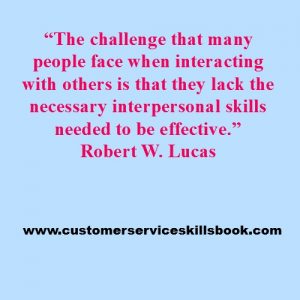Improving Verbal Communication with Customers
Many customer service representatives give little thought to the way that they sound to their customers. Typically, they have not received customer service skills training that addresses effective verbal communication. Similarly, they likely have not taken college or professional courses on effective interpersonal communication. The result is that they do not know how to improve their verbal communication with customers.
The following are three areas related to verbal communication that can have an impact on your success when you interact with your customers.
Articulation (sometimes called enunciation or pronunciation) refers to the clarity of your word usage. For example, if you tend to slur words (Whadju say? or I hafta go whitja) or cut off endings (goin’, doin’, gettin’, bein’), you can distort the meaning or frustrate some customers. This is especially true when communicating with customers who do not speak English well and with customers who view speech ability as an indication of educational achievement or your ability to assist them effectively. If you have a problem articulating well, practice by gripping a pencil horizontally between your teeth, reading sentences aloud, and forcing yourself to enunciate each word clearly. Over time, you will find that you slow down and form words more precisely.
Pauses are another tool that you can use in verbal communication with customers. Pauses can have either a positive or negative impact depending on how you use them. From a positive standpoint, they can be used to allow a customer to reflect on what you just said, to indicate that you are waiting for a response, or to verbally punctuate a point you made or a sentence. The latter is done through intonation and inflection in the voice, or. On the negative side, you can irritate someone through the use of too many vocal pauses or interferences. The pauses might be audible sounds (“uh,” “er,” “um,” “uh-huh”) and are often used when you have doubts or are unsure of what you are saying, not being truthful, or nervous. They are sometimes called verbal fillers.
Silence is a form of implied communication that can be used in a number of ways, some more productive than others. Many customer service representatives have trouble dealing with silence in a conversation. This is unfortunate because silence is a good way to show respect or show that you are listening to the customer while he or she speaks. It is also a simple way to indicate that the other person should say something or contribute some information after you have asked a question.
The topic of interpersonal communication cannot be addressed adequately in a single post due to its complexity. There are many factors that impact it. For example, in addition to the way that you communicate, you have to consider factors related to your customers (e.g. example, age, gender, diversity factors, and education level).
To expand your knowledge of the topic of verbal communication with customers, I suggest that you view other posts in this blog, search the Internet, read books, and attend workshops on the subject.


